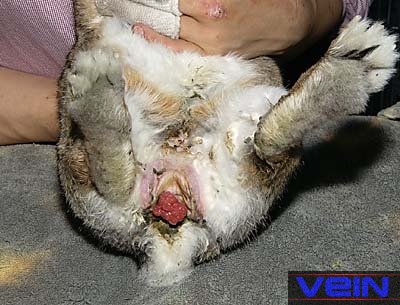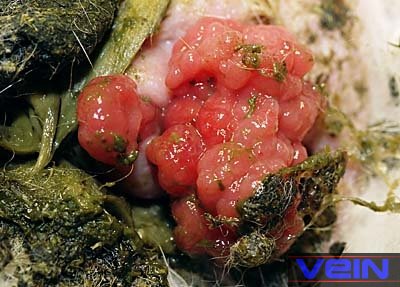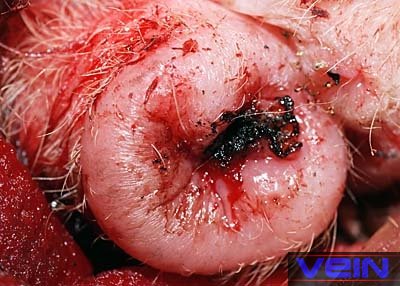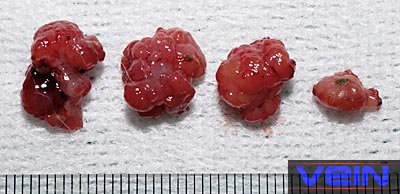Anal or anorectal papilloma
Esther van Praag Ph.D.
|
MediRabbit.com is funded solely by the generosity of donors. Every donation, no matter what the size, is appreciated and will aid in the continuing research of medical care and health of rabbits. Thank you |
Warning: this file contains pictures that may be distressing for some persons.
Small reddish excrescences sometimes protrude from the anus of rabbits. Their origin is not well-understood; they are not associated to the papilloma viruses causing oral or cutaneous papilloma (Shope papilloma virus).The cauliflower-like tumors arise at the mucocutaneous junction of the rectum and the anus. The tumors are well differentiated and benign. They bleed profusely when damaged.Clinical signs and diagnosisThe presence of rectal or anal papilloma is a cause of discomfort. They can, furthermore, lead to persistent, ineffectual spasms of the rectum with inability to defecate (fecal tenesmus). This can lead to misdiagnosis of stasis or inflammation of the intestine (colitis).TreatmentSpontaneous regression of the anorectal papilloma is possible. Surgical removal of the tumor remains, however, the treatment of choice as anal papilloma tumors are the result of pre-malignant transformations of squamous columnar cells of the anal or rectal mucosa. Ablative methods include classical surgical excision or destruction by laser, electrodissecation or liquid nitrogen. If the growth is located in the rectum, it can be accessed by everting the rectum through the anus (”pull-out technique”). It is important to remove the papilloma fully, including the basis to avoid recurrence. The tumor can be sent to a specialized laboratory for histopathologic analysis. If the tumor is invasive or presents cancerous characteristics, it should be excised with the widest margin possible. Post-surgical care includes the administration of NSAID’s analgesics to reduce the inflammation of tissues and to control pain, and a diet rich in fiber. Prognosis is good.
AcknowledgementThanks are due to Akira Yamanouchi, for the permission to use the papilloma pictures from VEIN (Veterinary Exotic Information Network). Further ReadingBourne D. Organisation Wildlife Information Network. https://www.wildlifeinformation.org/ Harcourt-Brown, F. Textbook of Rabbit Medicine. Publisher Reed Educational and Professional Publishing Ltd, Oxford, UK. 2002 Manning, P.J., Ringler, D.H. & Newcomer, C.E. The Biology of the Laboratory Rabbit - Second Edition. Publisher Academic Press Limited, 24-28 Oval Rd, London, UK. 1994 Quesenberry, K.E. & Carpenter J.W. Ferrets, Rabbits and Rodents - Clinical Medicine and Surgery. 2nd Edition. Publisher WB Saunders, Philadelphia, Pennsylvania, USA. 2004 |
e-mail: info@medirabbit.com







